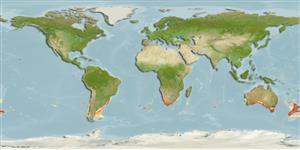Environment: milieu / climate zone / depth range / distribution range
ນິເວດວິທະຍາ
ສັດທະເລ ອາໄສຢູ່ໃກ້ໜ້າດິນໃຕ້ພື້ນທ້ອງນ້ຳ; ລະດັບຄວາມເລິກ 50 - 854 m (Ref. 52581). Subtropical; 28°S - 50°S, 180°W - 180°E
Circumglobal in southern waters: (Ref. 7300): South Africa, Australia, New Zealand, Kermadec I., Desventuradas Is., Juan Fernandez Is., Chile, north to southern Brazil, Tristan da Cunha.
Length at first maturity / ຂະໜາດ / ນ້ຳໜັກ / Age
Maturity: Lm 88.0 range ? - ? cm
Max length : 160 cm TL ຕົວຜູ້/ບໍ່ມີເພດ; (Ref. 89467); common length : 100.0 cm TL ຕົວຜູ້/ບໍ່ມີເພດ; (Ref. 9258); ນ້ຳໜັກສູງສຸດທີ່ເຄຍຈັດພີມມາ: 100.0 kg (Ref. 4537); ອາຍຸສູງສຸດທີ່ເຄຍລາຍງານມາ: 60 ປີ (Ref. 41439)
ຄີ (ໜາມ)ແຂງຢູ່ຫຼັງປາ (ທັງໝົດ): 9 - 12; ຄີຫຼັງຂອງປາ (ຄີອ່ອນ) (ທັງໝົດ): 12; ຄີ(ໜາມ) ແຂງຢູ່ຄີກົ້ນປາ
ກຸ່ມປາກະດູກແຂງ
ຄວາມຖີ່ຂອງກຸ່ມຖ່າຍທອດພັນ
ປາທີ່ມີການເຄື່ອນຍ້າຍຈາກທະເລໄປຫານ້ຳຈືດ ແລະນ້ຳຈືດຫາທະເລ
ປາທີ່ມີການເຄື່ອນຍ້າຍຈາກທະເລແລະໄປໄຂ່ຢູ່ນ້ຳຈືດ
ຄີກົ້ນຂອງປາ
ສັດທີ່ມີກະດູກສັນຫັຼງ
ການຖ່າຍທອດທາງກຳມະພັນຈາກພໍ່ແມ່ຫາລູກ 3; ຄີກົ້ນຂອງປາ: 7 - 9
A deepwater species, occurs in seamounts (Ref. 89357). Adults occur generally over rough ground from the central shelf (about 100 m) to the shelf edge and down to the upper slope. Juveniles are found in surface waters, perhaps school in association with drifting weed. Feed on barracouta and pilchards, in addition to various bottom-dwelling fish. Are primary gonochorists (Ref. 58421). Preyed upon by sperm whales (Ref. 9072). It is taken by droplining down to 400 m, and is sometimes seen in the trawled catch. Utilized fresh and frozen; can be steamed, fried, broiled, boiled, microwaved and baked (Ref. 9988). Severely overfished (Ref. 89357).
Are primary gonochorists (Ref. 58421).
Paxton, J.R., D.F. Hoese, G.R. Allen and J.E. Hanley, 1989. Pisces. Petromyzontidae to Carangidae. Zoological Catalogue of Australia, Vol. 7. Australian Government Publishing Service, Canberra, 665 p. (Ref. 7300)
IUCN Red List Status (Ref. 130435)
Threat to humans
Harmless
Human uses
ການປະມົງ: ເປັນສີນຄ້າ; ຊະນິດປາທີ່ຖືກນຳໃຊ້ເຂົ້າໃນການຫາເພື່ອເປັນເກມກິລາ: ແມ່ນ
ເຄື່ອງມື
Special reports
Download XML
ແຫຼ່ງອີນເຕີເນັດ
Estimates based on models
Preferred temperature (Ref.
123201): 8.6 - 16, mean 11.7 °C (based on 143 cells).
Phylogenetic diversity index (Ref.
82804): PD
50 = 0.8125 [Uniqueness, from 0.5 = low to 2.0 = high].
Bayesian length-weight: a=0.01072 (0.00765 - 0.01500), b=2.99 (2.89 - 3.09), in cm total length, based on LWR estimates for this species (Ref.
93245).
ຊັ້ນເຂດຮ້ອນ (Ref.
69278): 4.5 ±0.77 se; based on food items.
ຄວາມຢືດຢຸ່ນ (Ref.
120179): ຕຳ່ຫຼາຍ, ປະຊາກອນຕຳ່ສຸດທີ່ໃຊ້ເວລາສອງເທົ່າຫຼາຍກວ່າ 14 ປີ (tm=10-13; tmax=60).
Fishing Vulnerability (Ref.
59153): High vulnerability (59 of 100).
Climate Vulnerability (Ref.
125649): High to very high vulnerability (70 of 100).
Nutrients (Ref.
124155): Calcium = 34 [20, 61] mg/100g; Iron = 0.904 [0.538, 1.528] mg/100g; Protein = 21 [20, 22] %; Omega3 = 0.563 [0.318, 1.046] g/100g; Selenium = 55.6 [29.6, 108.8] μg/100g; VitaminA = 9.09 [3.16, 24.94] μg/100g; Zinc = 0.368 [0.267, 0.532] mg/100g (wet weight); based on
nutrient studies.
